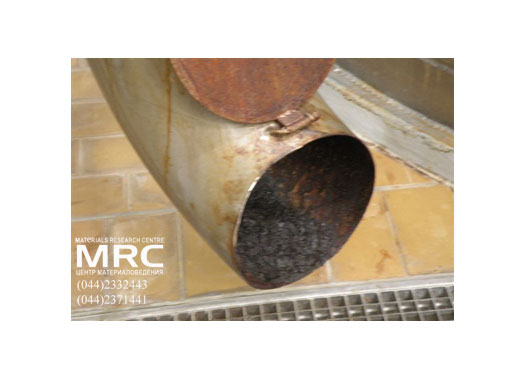 |
Study of the stainless steel sample chemical composition
The testing was done to prevent corrosion of metal by means of strengthening the walls while adding more resistant metals into an alloy.
Chemical analysis of stainless steel samples such as cuttings and fine pieces, taken from the following stainless vessels: “upper ring of the vessel and overflow pipe of V-80 vessel” (general view on a photo 1). Separate samples of the material taken from “upper ring of the vessel V-80” like cuttings (photo 2), “overflow pipe of V-80 vessel” such as fine pieces (photo 3) and «frame of the graphite filter» (general view on photo 4) like cuttings (photo 5).
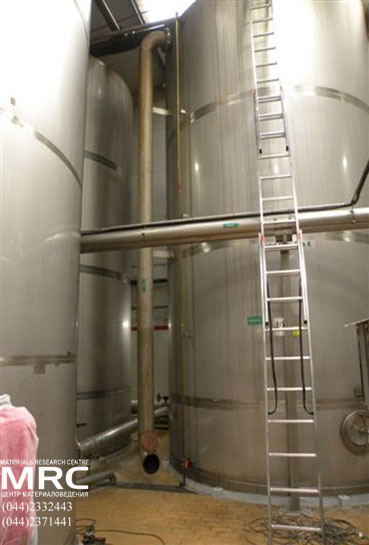 | 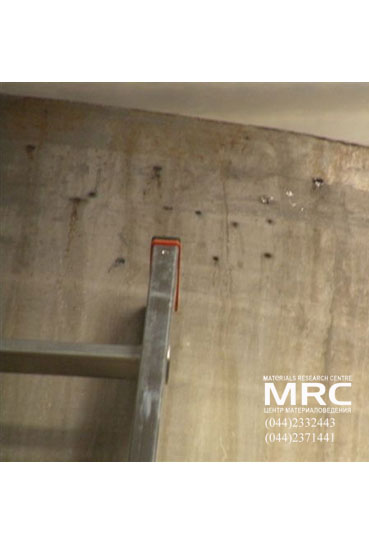 |
|---|---|
| Photo 1: Upper ring of the vessel and overflow pipe | Photo 2: Intake of the material from upper ring of the vessel like cuttings |
 |
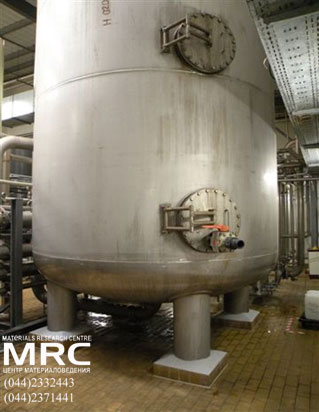 |
| Photo 3: Intake of the material from overflow pipe in a form of fine pieces | Photo 4: Carbon filter frame |
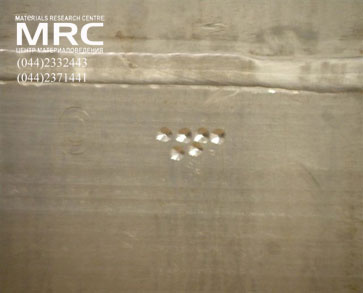 |
Photo 5: a stainless steel sample in a form of cuttings |
Composition analysis of stainless steel three samples: «overflow pipe of a vessel and overflow pipe of V-80 vessel», «upper ring of a vessel and overflow pipe of vessel V-80» and «frame of the graphite filter».
Table 1 – Results obtained by X-Ray micro spectrum analysis:
|
Samples |
Elements content in an iron-based alloy, mass% |
|||||
|
Cr |
Ni |
Mo |
Mn |
Ti |
Si |
|
|
Overflow pipe V-80 |
16,28 |
11,99 |
2,42 |
1,80 |
0,54 |
0,68 |
|
Upper ring of a vessel V-80 |
16,39-17,12 |
11,02-11,06 |
2,11-2,57 |
1,69 |
0,40-0,39 |
0,44-0,42 |
|
Frame of a graphite filter |
16,02-16,43 |
10,47-10,68 |
2,43-3,03 |
1,53-1,70 |
0,39-0,45 |
0,54-0,75 |
Obtained results show that all samples (“an overflow pipe of the V-80 vessel”, “upper ring of the V-80 vessel” and “frame of the graphite filter”) are close to the composition of steel AISI 316L, in accordance with ASTM A240, by their metallic properties (see Table 2).
In “frame of the graphite filter” sample the molybdenum content is on the upper height. In “overflow pipe of V-80 vessel” titanium content is on upper height. Scattering is shown based on two testing for determining content in different areas. Obviously, it, mainly, characterizes method of accuracy determining as metal (sheet) is deformed greatly and averaging of licvations by composition has occurred.
More corrosion-resistant alloy AISI 316L is differing from alloy AISI 316 by titanium presence and lower content of carbon: 0,03 instead of 0,08 mass % (see Table 2). The analysis of carbon content by chemical method showed that in all steel grades the content of carbon is ranging between 0,073-0,08 mass %. This corresponds to a maximum content of carbon in alloy AISI 316. Additional control by means of spectrum analysis confirmed presence of titanium in the alloys.
The samples correspond to alloy AISI 316. Obviously, ASTM A240 does not guarantee presence of titanium in its composition. Table. 2 – Chemical composition of stainless steel grades type AISI 316 in accordance with ASTM A240:
| Samples |
C |
Mn |
P |
S |
Si |
Cr |
Ni |
Mo |
Ti |
|
AISI 316 |
0.08 max |
2.0 |
0.045 |
0.030 |
1.0 |
16.0 |
10.0 |
2.00 |
- |
|
AISI 316L |
0.03 max |
0.5 max |
|||||||
|
AISI 316Ti |
0.08 max |
5X%C |
AISI 316 grade – improved version 304, with molybdenum and higher content of nickel.
The given composition of AISI 316 considerably increases corrosion resistance in aggressive media. Molybdenum makes steel more protected from pitting and slotted corrosion in chlorine medium, sea water and vapors of acetic acid. AISI 316 has higher strength and has better resistance of creeping at high temperatures, than AISI 304. AISI 316 also has good mechanical and corrosion properties at negative temperatures.
When there is a risk of corrosion near welding areas, a low-carbon grade AISI 316L should be used.
AISI 316Ti version, stabilized with titanium is used to improve thermal stability within considerable period of time in a temperature range 550-800°C.



 Highlights
Highlights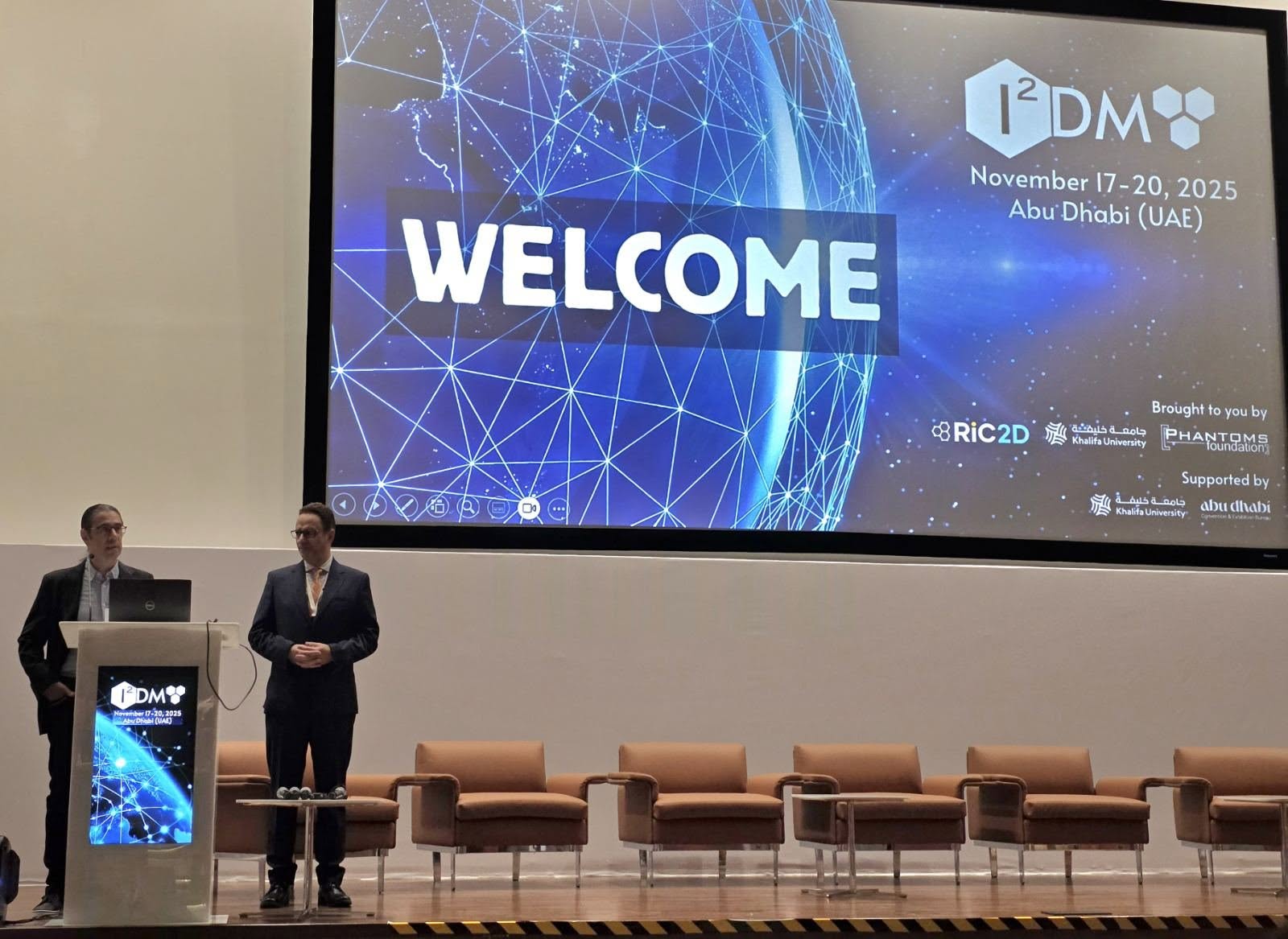 We are excited to share that our Carbon-Ukraine (Y-Carbon LLC) company participated in the I2DM Summit and Expo 2025 at Khalifa University in Abu-Dhabi! Huge thanks to Research & Innovation Center for Graphene and 2D Materials (RIC2D) for hosting such a high-level event.It was an incredible opportunity to meet brilliant researchers and innovators working on the next generation of 2D materials. The insights and energy from the summit will definitely drive new ideas in our own development.
We are excited to share that our Carbon-Ukraine (Y-Carbon LLC) company participated in the I2DM Summit and Expo 2025 at Khalifa University in Abu-Dhabi! Huge thanks to Research & Innovation Center for Graphene and 2D Materials (RIC2D) for hosting such a high-level event.It was an incredible opportunity to meet brilliant researchers and innovators working on the next generation of 2D materials. The insights and energy from the summit will definitely drive new ideas in our own development. Carbon-Ukraine team had the unique opportunity to visit XPANCEO - a Dubai-based deep tech startup company that is developing the first smart contact lenses with AR vision and health monitoring features, working on truly cutting-edge developments.
Carbon-Ukraine team had the unique opportunity to visit XPANCEO - a Dubai-based deep tech startup company that is developing the first smart contact lenses with AR vision and health monitoring features, working on truly cutting-edge developments. Our Carbon-Ukraine team (Y-Carbon LLC) are thrilled to start a new RIC2D project MX-Innovation in collaboration with Drexel University Yury Gogotsi and Khalifa University! Amazing lab tours to project collaborators from Khalifa University, great discussions, strong networking, and a wonderful platform for future collaboration.
Our Carbon-Ukraine team (Y-Carbon LLC) are thrilled to start a new RIC2D project MX-Innovation in collaboration with Drexel University Yury Gogotsi and Khalifa University! Amazing lab tours to project collaborators from Khalifa University, great discussions, strong networking, and a wonderful platform for future collaboration.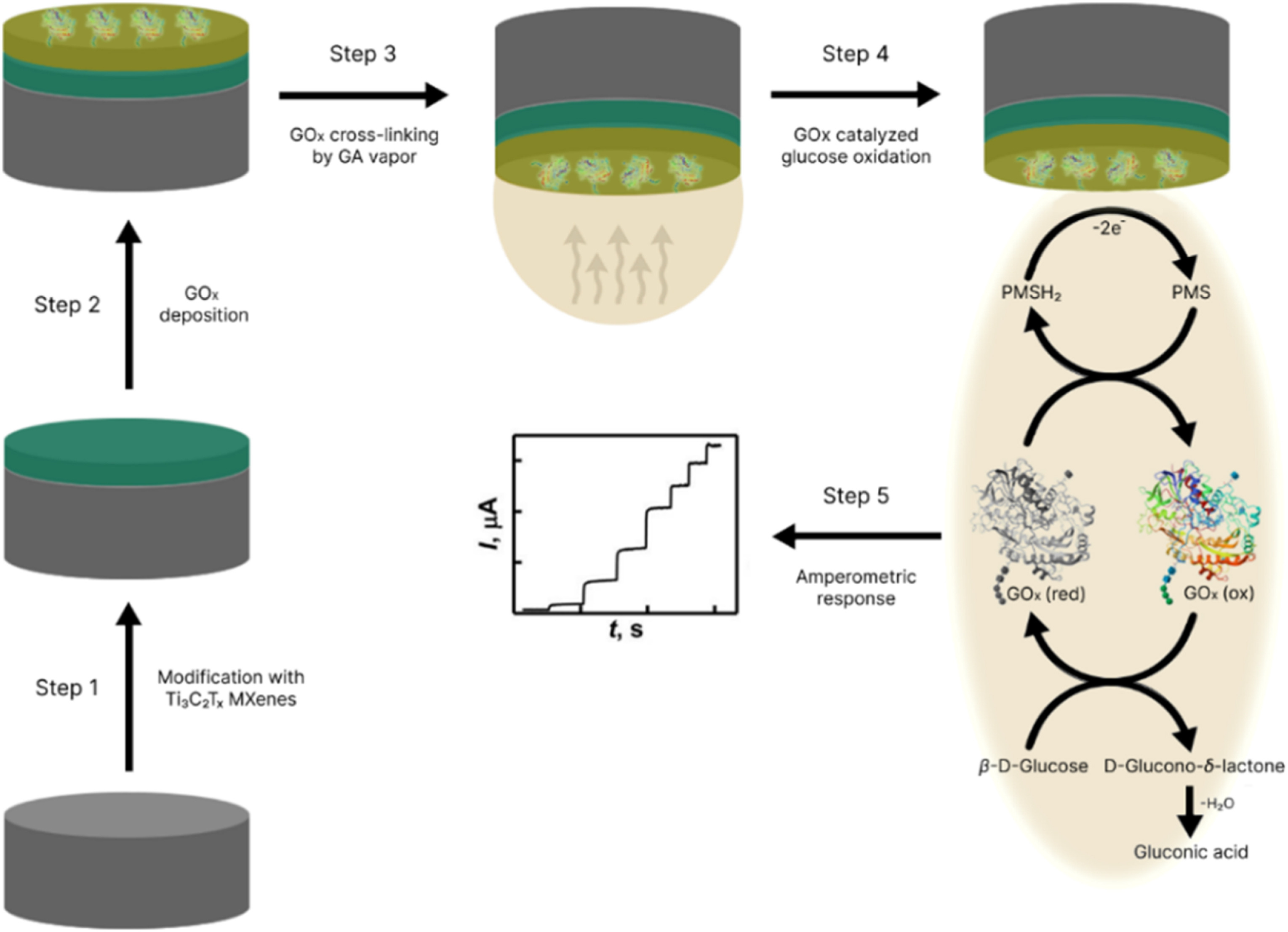
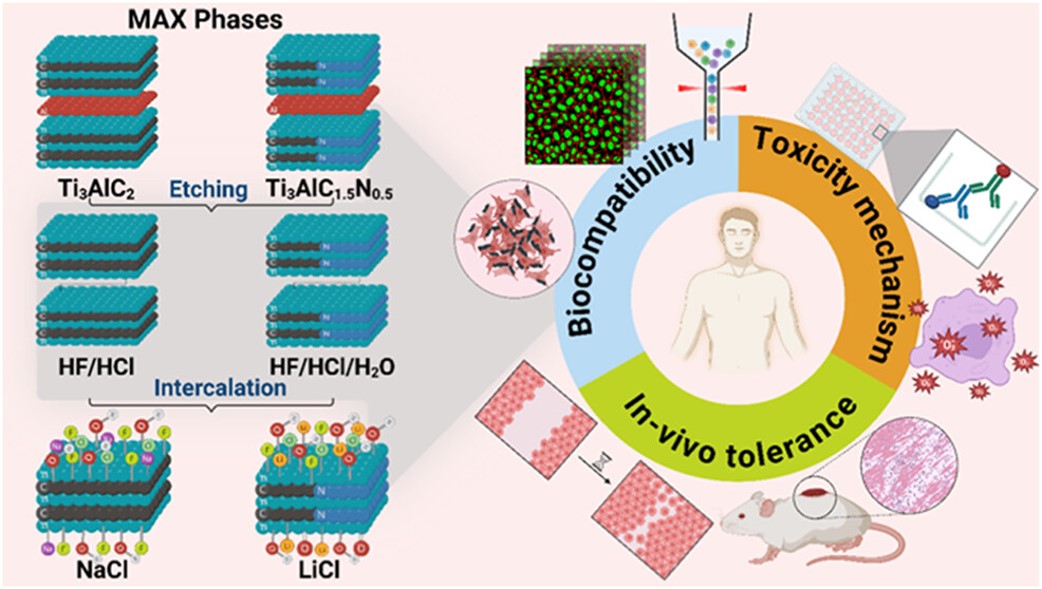 MXenes potential applications include sensors, wound healing materials, and drug delivery systems. A recent study explored how different synthesis methods affect the safety and performance of MXenes. By comparing etching conditions and intercalation strategies, researchers discovered that fine-tuning the surface chemistry of MXenes plays a crucial role in improving biocompatibility. These results provide practical guidelines for developing safer MXenes and bring the field one step closer to real biomedical applications.
MXenes potential applications include sensors, wound healing materials, and drug delivery systems. A recent study explored how different synthesis methods affect the safety and performance of MXenes. By comparing etching conditions and intercalation strategies, researchers discovered that fine-tuning the surface chemistry of MXenes plays a crucial role in improving biocompatibility. These results provide practical guidelines for developing safer MXenes and bring the field one step closer to real biomedical applications. An excellent review highlighting how MXene-based sensors can help tackle one of today’s pressing environmental challenges — heavy metal contamination. Excited to see such impactful work moving the field of environmental monitoring and sensor technology forward!
An excellent review highlighting how MXene-based sensors can help tackle one of today’s pressing environmental challenges — heavy metal contamination. Excited to see such impactful work moving the field of environmental monitoring and sensor technology forward!
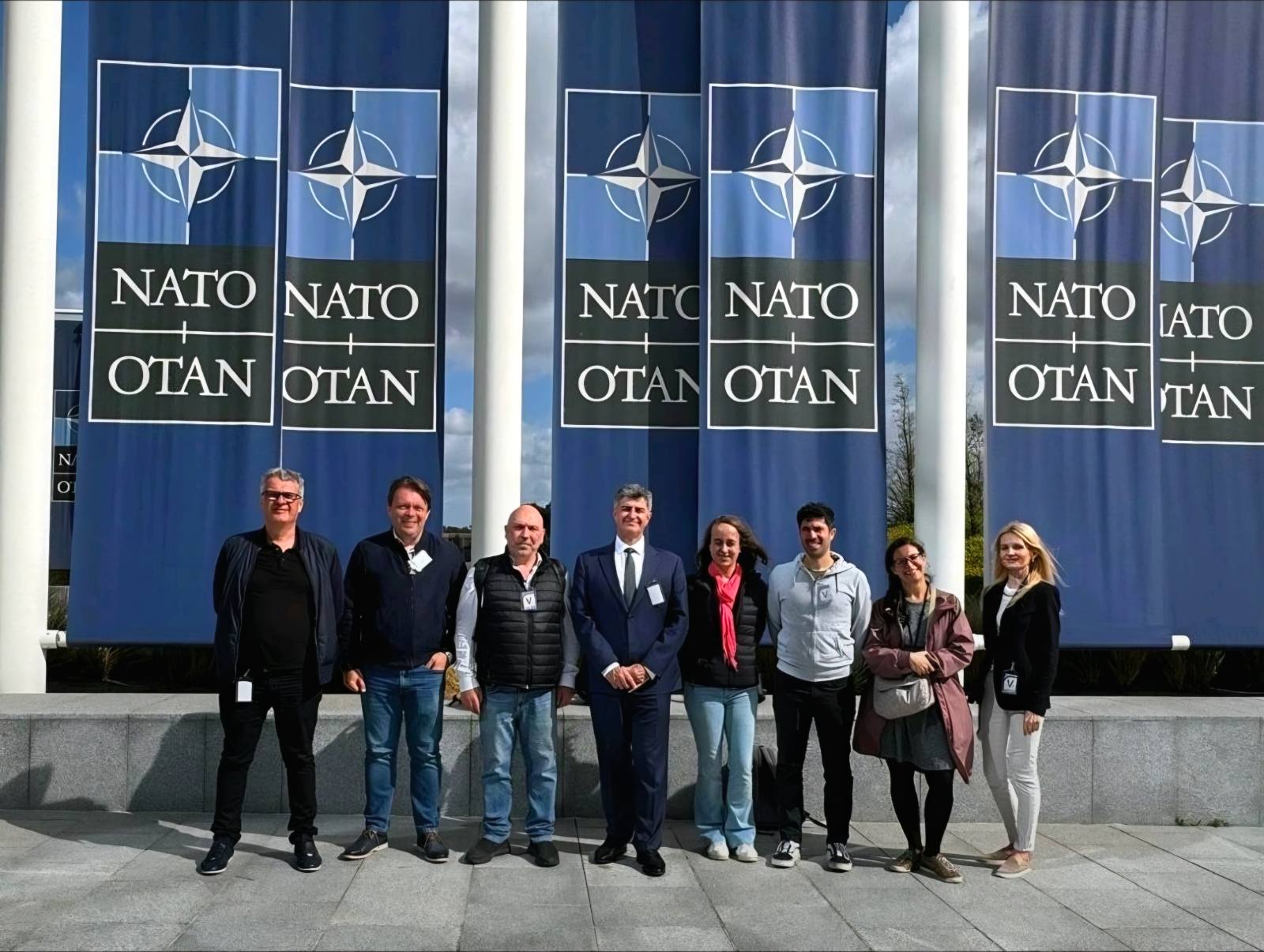 Carbon-Ukraine team was truly delighted to take part in the kickoff meeting of the ATHENA Project (Advanced Digital Engineering Methods to Design MXene-based Nanocomposites for Electro-Magnetic Interference Shielding in Space), supported by NATO through the Science for Peace and Security Programme.
Carbon-Ukraine team was truly delighted to take part in the kickoff meeting of the ATHENA Project (Advanced Digital Engineering Methods to Design MXene-based Nanocomposites for Electro-Magnetic Interference Shielding in Space), supported by NATO through the Science for Peace and Security Programme. Exellent news, our joint patent application with Drexel University on highly porous MAX phase precursor for MXene synthesis published. Congratulations and thanks to all team involved!
Exellent news, our joint patent application with Drexel University on highly porous MAX phase precursor for MXene synthesis published. Congratulations and thanks to all team involved!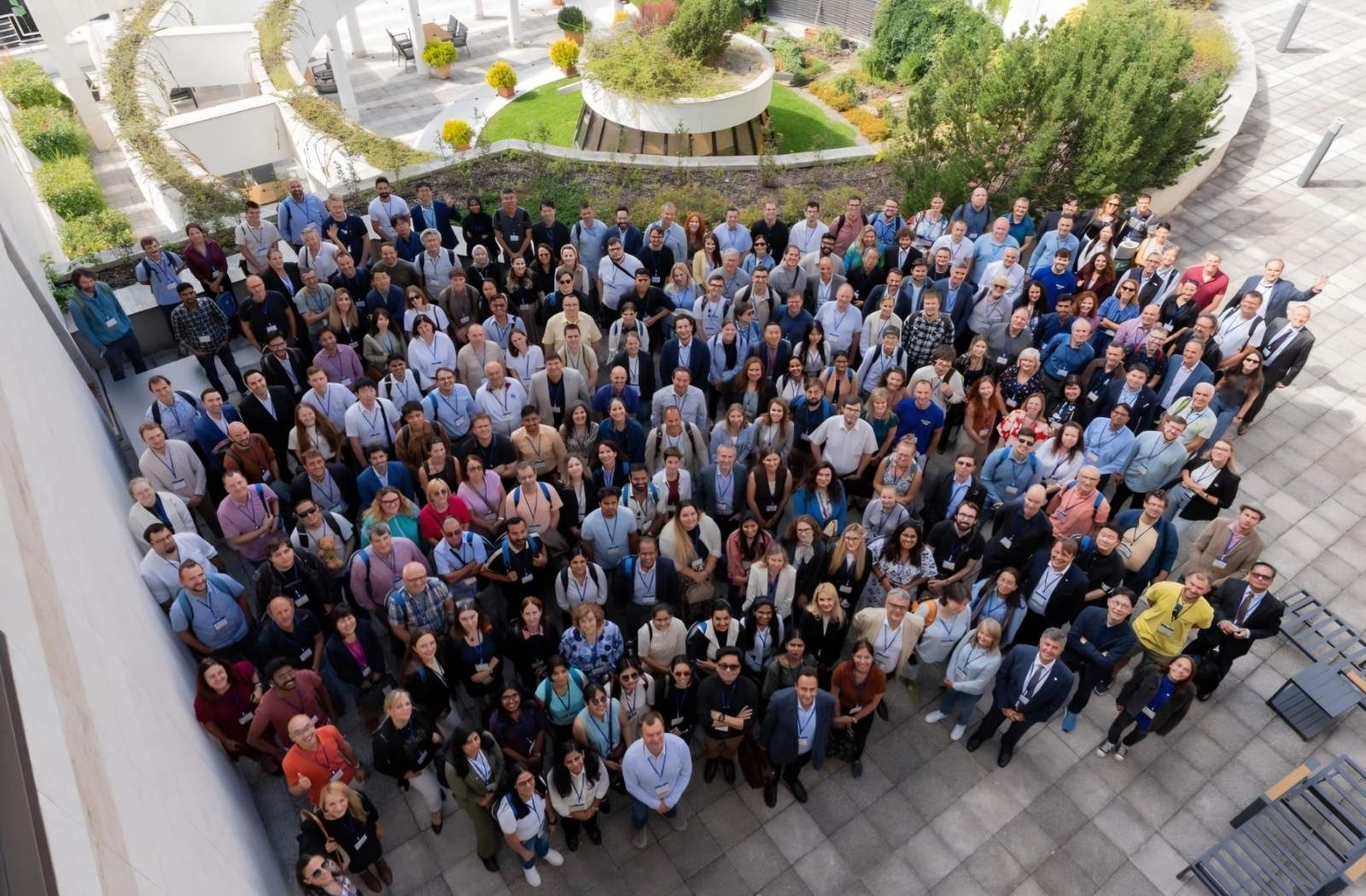 Our team was very delighted to take part in International Symposium "The MXene Frontier: Transformative Nanomaterials Shaping the Future" – the largest MXene event in Europe this year!
Our team was very delighted to take part in International Symposium "The MXene Frontier: Transformative Nanomaterials Shaping the Future" – the largest MXene event in Europe this year!  Last Call! Have you submitted your abstract for IEEE NAP-2025 yet? Join us at the International Symposium on "The MXene Frontier: Transformative Nanomaterials Shaping the Future" – the largest MXene-focused conference in Europe this year! Final Submission Deadline: May 15, 2025. Don’t miss this exclusive opportunity to showcase your research and engage with world leaders in the MXene field!
Last Call! Have you submitted your abstract for IEEE NAP-2025 yet? Join us at the International Symposium on "The MXene Frontier: Transformative Nanomaterials Shaping the Future" – the largest MXene-focused conference in Europe this year! Final Submission Deadline: May 15, 2025. Don’t miss this exclusive opportunity to showcase your research and engage with world leaders in the MXene field! We are excited to announce the publication of latest review article on MXenes in Healthcare. This comprehensive review explores the groundbreaking role of MXenes—an emerging class of 2D materials—in revolutionizing the fields of medical diagnostics and therapeutics. Read the full article here: https://doi.org/10.1039/D4NR04853A.
We are excited to announce the publication of latest review article on MXenes in Healthcare. This comprehensive review explores the groundbreaking role of MXenes—an emerging class of 2D materials—in revolutionizing the fields of medical diagnostics and therapeutics. Read the full article here: https://doi.org/10.1039/D4NR04853A. Congratulations and thank you to our collaborators from TU Wien and CEST for very interesting work and making it published! In this work, an upscalable electrochemical MXene synthesis is presented. Yields of up to 60% electrochemical MXene (EC-MXene) with no byproducts from a single exfoliation cycle are achieved.
Congratulations and thank you to our collaborators from TU Wien and CEST for very interesting work and making it published! In this work, an upscalable electrochemical MXene synthesis is presented. Yields of up to 60% electrochemical MXene (EC-MXene) with no byproducts from a single exfoliation cycle are achieved. Congratulations to all collaborators with this interesting joint work!
Congratulations to all collaborators with this interesting joint work!